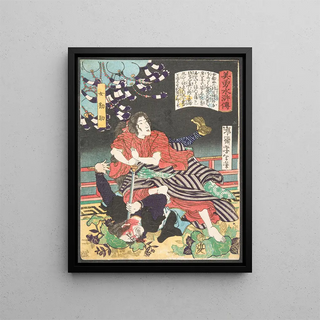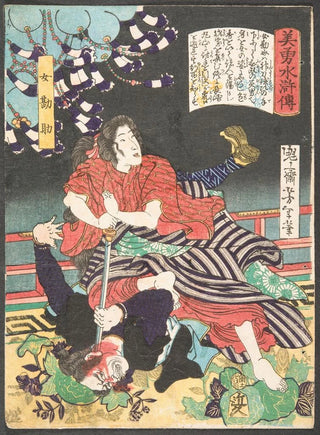Art print | The woman Kansuke killing an attacker with a sword - Tsukioka Yoshitoshi


View from behind

Frame (optional)
In the fascinating world of Japanese art, the art print "The Woman Kansuke Killing an Attacker with a Sword" by Tsukioka Yoshitoshi stands out for its narrative power and emotional depth. This iconic piece, from the Edo era, not only demonstrates the artist's technical mastery but also reflects the cultural and historical values of Japan during that period. By capturing a moment of dramatic tension, Yoshitoshi immerses us in a scene where the courage and determination of a female warrior are magnified, thus revealing often overlooked stories from Japanese history. This work, both captivating and striking, invites viewers to reflect on the role of women in samurai society, while celebrating their indomitable strength.
Style and uniqueness of the work
Yoshitoshi's style is characterized by a bold blend of realism and stylization, where every detail is carefully crafted to convey intense emotion. In "The Woman Kansuke Killing an Attacker with a Sword," vibrant colors and dynamic lines create an atmosphere of palpable tension. The depiction of the woman, both vulnerable and powerful, is enhanced by compositional elements that direct the viewer's gaze toward the central action. Facial expressions and postures of the characters are of rare expressiveness, demonstrating a mastery of human anatomy that shows deep respect for tradition while innovating in storytelling techniques. Each brushstroke seems to vibrate with an energy that transcends the simple painting, inviting immersion into a rich and complex narrative.
The artist and his influence
Tsukioka Yoshitoshi, born in 1839, is often regarded as one of the last great masters of ukiyo-e printmaking. His artistic journey was marked by a period of transition in Japan, where Western influences began to infiltrate a traditionally rooted art form. Yoshitoshi, as an artist, skillfully navigated between these two worlds, integrating modern techniques while preserving the essence of ukiyo-e. His

Matte finish

View from behind

Frame (optional)
In the fascinating world of Japanese art, the art print "The Woman Kansuke Killing an Attacker with a Sword" by Tsukioka Yoshitoshi stands out for its narrative power and emotional depth. This iconic piece, from the Edo era, not only demonstrates the artist's technical mastery but also reflects the cultural and historical values of Japan during that period. By capturing a moment of dramatic tension, Yoshitoshi immerses us in a scene where the courage and determination of a female warrior are magnified, thus revealing often overlooked stories from Japanese history. This work, both captivating and striking, invites viewers to reflect on the role of women in samurai society, while celebrating their indomitable strength.
Style and uniqueness of the work
Yoshitoshi's style is characterized by a bold blend of realism and stylization, where every detail is carefully crafted to convey intense emotion. In "The Woman Kansuke Killing an Attacker with a Sword," vibrant colors and dynamic lines create an atmosphere of palpable tension. The depiction of the woman, both vulnerable and powerful, is enhanced by compositional elements that direct the viewer's gaze toward the central action. Facial expressions and postures of the characters are of rare expressiveness, demonstrating a mastery of human anatomy that shows deep respect for tradition while innovating in storytelling techniques. Each brushstroke seems to vibrate with an energy that transcends the simple painting, inviting immersion into a rich and complex narrative.
The artist and his influence
Tsukioka Yoshitoshi, born in 1839, is often regarded as one of the last great masters of ukiyo-e printmaking. His artistic journey was marked by a period of transition in Japan, where Western influences began to infiltrate a traditionally rooted art form. Yoshitoshi, as an artist, skillfully navigated between these two worlds, integrating modern techniques while preserving the essence of ukiyo-e. His






